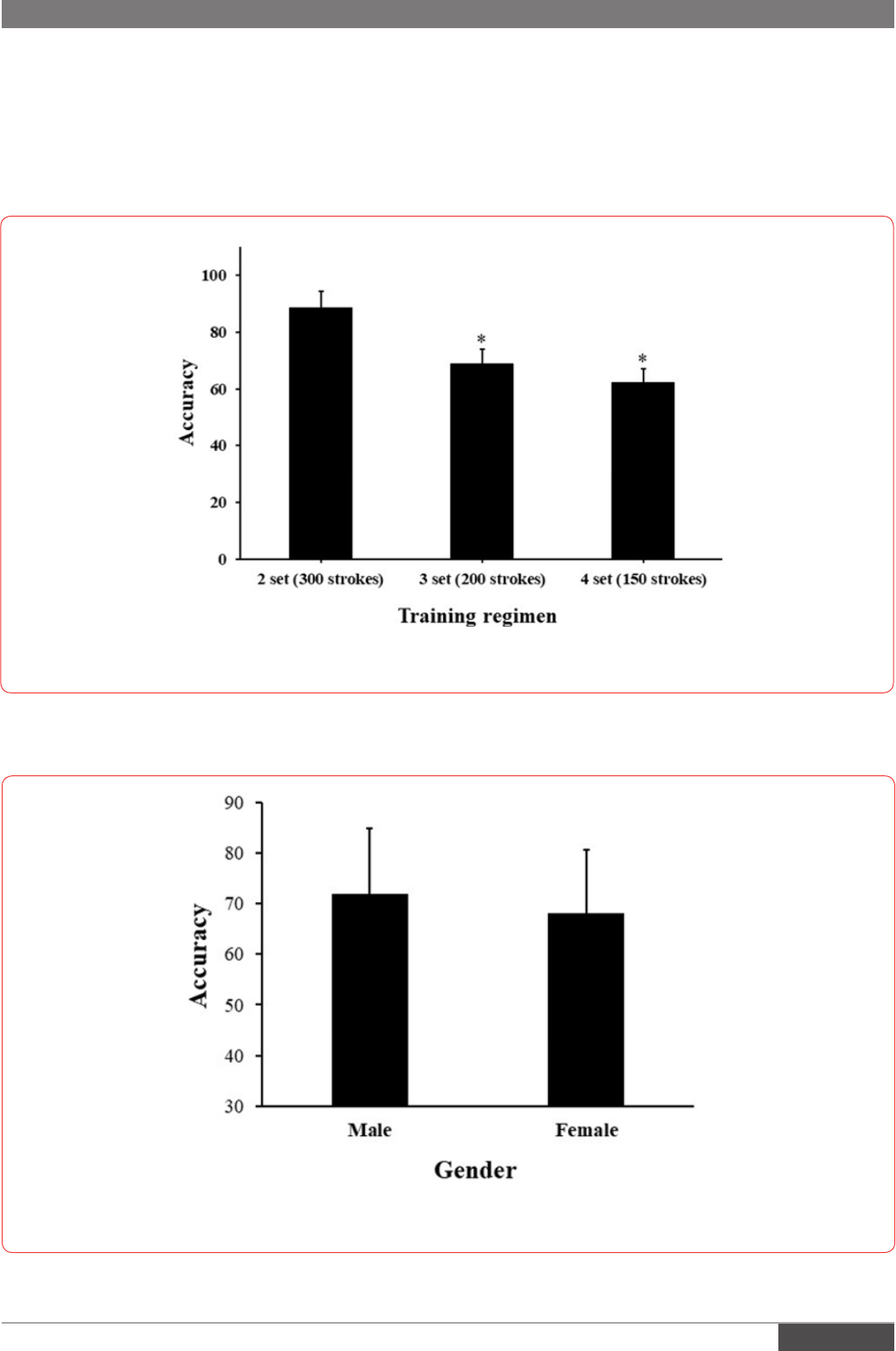
Page 1 of 5
Effects of Training Regimens and Differences Between
Sexes on Forehand Drives Accuracy in Table Tennis
ISSN: 2644-2981 DOI: 10.33552/GJNFS.2024.04.000600
Global Journal of
Nutrition & Food Science
Research Article
Copyright © All rights are reserved by Tomoliyus
Received Date: May 06, 2024
Published Date: May 14, 2024
This work is licensed under Creative Commons Attribution 4.0 License
GJNFS.MS.ID.000600.
*Corresponding author: Tomoliyus, Faculty of Sport Sciences, Yogyakarta
State University, Yogyakarta, Indonesia
Introduction
Table tennis is a sport that requires fundamental techniques
to be learned and mastered. Each technique has a very important
role in this game. Players who have good hitting skills, but are not
supported by other techniques or abilities, such as forehand drive
and footwork, are still considered as imperfect players [1]. Based
on the observations in 5 table tennis training stations in Yogyakarta,
Indonesia, beginner athletes who undertake table tennis training
generally do not have good target accuracy, especially for new
athletes. This can be observed from the movement of athletes
in ball striking during practice. In the game of table tennis, it is
necessary to hit the target precisely to win the game. Thus, the
factor of accuracy in table tennis is exclusively important in order
return the stroke during the match (Wong, 2020). Even more, this
is one of the factors that fails novice athletes to improve their skills
in table tennis [2]. The training using the appropriate set and stroke
repetitions by multi-ball method is indispensable because this
might be conceivable to improve the performance of athletes to have
Abstract
Background: Accuracy has become one of the prominent factors to improve the skills to counterattack the opponent in table tennis. An accurate
Objective: This study aims to evaluate the effects of training regimens and differences between sexes on forehand drive accuracy of table tennis
athletes at STMY club, Yogyakarta.
Methods:
drive accuracy using multi-ball training practice. The population in this study were 30 STMY table tennis athletes who were still actively practicing
table tennis. The athletes were further grouped into 6 sub-groups as assigned by the design based on the gender (male and female) and training
regimens; 2-set, 3-set, and 4-set for 300, 200, and 150 strokes, respectively. Then, the forehand drive accuracy was performed.
Results:
athletes at approximately 88.70 ± 5.83 as compared to 3 and 4-set training regimens (p < 0.05). Separately, male athletes have the tendency to
possess the better accuracy than that in female athletes.
Conclusion: The training regimen of 2-set with 300 strokes was the recommended training program to improve the accuracy of forehand drive
of the table tennis athletes at STMY club.
Keywords: Training regimen; Gender; Accuracy; Forehand drive
Ardiansyah Rica Samsu Goli
1
, Tomoliyus
1
*, Sumarjo
1
, Arman Syah Goli
2
1
Faculty of Sport Sciences, Yogyakarta State University, Yogyakarta, Indonesia
2
Department of Endocrinology and Metabolism, Faculty of Medicine, University of Tsukuba, Tsukuba, Ibaraki, Japan

Global Journal of Nutrition & Food Science Volume 4-Issue 5
Citation: Ardiansyah Rica Samsu Goli, Tomoliyus*, Sumarjo, Arman Syah Goli. Effects of Training Regimens and Differences Between Sexes on
Forehand Drives Accuracy in Table Tennis. 4(5): 2024. GJNFS.MS.ID.000600. DOI: 10.33552/GJNFS.2024.04.000600.
Page 2 of 5
substantially better accuracy abilities. This is in accordance with
improvements on visual abilities and counter-attack skills of
junior table tennis players through the multi-ball training model
[3]. Successfulness to perform the good accuracy is unavoidably
affected by training and skill factors. Therefore, this training process
will support the novice athletes to become outstanding athletes. As
far as the present authors are concerned, there are no published
works reporting the effects of training regimens and differences
between sexes on the accuracy of forehand drives strokes at table
tennis clubs in Yogyakarta. Therefore, this study aimed to evaluate
the effects of training regimens and differences between sexes on
the accuracy of forehand drive of male and female athletes at STMY
Yogyakarta club.
Participants And Methods
Participants and study allocation
In this study, a total of 30 beginner athletes aged 18-25 years
old was recruited from the STMY Yogyakarta club, Indonesia. The
participants were 15 male and 15 female athletes that equally
randomized into 6 groups based on gender and training regimen.
This study was conducted from January to July 2023.
Study procedures
A factorial design (2 x 3) was used to select the best performance.
The independent factors consisting of male (B1) and female (B2)
were applied and training regimens which was divided into 3 sets,
such as 2-set (A1), 3-set (A2), and 4-set (A3) were used to observe
the effect of various factors towards the critical parameters during
the training. A total of 6 sub-groups generated are presented in
(Table 1). This study was conducted for 18 weeks with the training
frequency of 3 times per week. The athletes were assigned to
perform the multiball-training treatment at 300, 200, and 150
stroke repetitions for 2-set, 3-set and 4-set, respectively, with 1
minute break. The accuracy was measured using accuracy test by
employing a table tennis forehand drive accuracy instrument, as
displayed in Figure 1.
Figure 1: Image of Forehand Drive Precision Capability Instrument. X: Testimonials and Y: Feeder
Table 1: Experimental design using factorial design (2 x 3).
Gender
Training regimens
2-set (A1) 3-set (A2) 4-set (A3)
Male (B1) A1B1 A2B1 A3B1
Female (B2) A1B2 A2B2 A3B2
Statistical analysis
Data were expressed as mean ± standard deviation (SD). Data
with more than two groups were statistically analysed using one-
way analysis of variance (ANOVA). Data with only two groups were
was taken at p < 0.05. Statistical analyses were performed using
SPSS Statistics 26 (IBM, Armonk, NY, USA).

Citation: Ardiansyah Rica Samsu Goli, Tomoliyus*, Sumarjo, Arman Syah Goli. Effects of Training Regimens and Differences Between Sexes on
Forehand Drives Accuracy in Table Tennis. 4(5): 2024. GJNFS.MS.ID.000600. DOI: 10.33552/GJNFS.2024.04.000600.
Global Journal of Nutrition & Food Science Volume 4-Issue 5
Page 3 of 5
Results
Effects of training regimens on forehand drive accuracy
As presented in Figure 2 the forehand drive accuracy of
combined male and female athletes ranged from 55.08 to 96.02.
strokes) training regimen than that of 3-set (200 strokes) and
4-set (150 strokes) of training regimens (p < 0.05). However, there
training regimens.
Figure 2: Eect of training regimens on forehand drive accuracy. *: p < 0.05 as compared to 2-set (300 strokes)
Effects of gender on forehand drive accuracy
Figure 3: Eect of gender on forehand drive accuracy

Global Journal of Nutrition & Food Science Volume 4-Issue 5
Citation: Ardiansyah Rica Samsu Goli, Tomoliyus*, Sumarjo, Arman Syah Goli. Effects of Training Regimens and Differences Between Sexes on
Forehand Drives Accuracy in Table Tennis. 4(5): 2024. GJNFS.MS.ID.000600. DOI: 10.33552/GJNFS.2024.04.000600.
Page 4 of 5
Figure 3 represents the results of forehand drive accuracy
between male and female athletes. The result exhibited that the
forehand drive accuracy of the combined training regimens was
not statistically difference between male and female after 18 weeks
training. However, there was a clear tendency showing that the
forehand drive accuracy of male athletes was higher than that of
woman athletes.
Discussion
The table tennis athletes at STMY Yogyakarta club require a
variety of types of training to improve the strokes accuracy. One
of the goals of performing a variety of exercises is to improve the
muscular and stamina endurance of athletes during the match
[4,5]. There are several training methods in table tennis, according
to [6] training methods in table tennis include practicing with
other players, practicing with a coach, individual practice, using
machines as well as multi-ball. From the various methods in table
tennis, one of the training methods used to improve the accuracy
of the forehand drive strokes is the multiball training method
[7-9]. This training method emphasizes the number of sets and
strokes, thus enabling athletes to familiarize hitting the ball at the
expected target precisely. The multiball method can be executed
using machines or manuals provided by trainers [10]. However,
STMY table tennis in Yogyakarta does not have an automatic
machine, so, the manual multiball method is more convenient and
accessible to improve the accuracy of athletes’ forehand drives. The
high frequency of practicing the forehand drive accuracy by hitting
the ball as much as possible is expected to create the accustomed
athletes on perfectly generating the precise strokes on target [11-
13]. Accordingly, exercise using multiball is selected by the coach
in this study. One of the goals of multi-ball training is to improve
the athlete’s forehand drive accuracy. As shown in the results, there
accuracy of athletes at the STMY table tennis club. Interestingly,
the group with 2-set (300 strokes) training regimen obtained
the highest accuracy with an average of 88.70 ± 5.83 among all
in particular, there was an increase in forehand drive accuracy
of 9.80, with a percentage increase of 21.30% in 2-set frequency
players to direct a stroke to the interested target. Accuracy is an
indispensable factor for table tennis player to achieve the precise
target [15,16] Several studies have proven that there was a positive
correlation between frequency of stroke repetitions and accuracy
in sports which means that the higher the frequency of training,
the higher the accuracy will be obtained by the players [17,18] In
training that consist of 300 strokes repetition and categorized as
the highest repetition than other set of training regimens. Thus, this
might be the potential reason explaining that the training regimen
drive accuracy among the table tennis athletes in this study.
Furthermore, the tendency of higher accuracy was obtained by
male athletes at the STMY table tennis club. Based on the results
of the analysis, the forehand drive strokes accuracy of male group
with an average of 72.00 ± 12.78 was better than that of female
group with an average of 68.00 ± 12.61. Physiologically, table
tennis is facilitated by sexual dimorphism. According to some
studies, male athletes are prone to faster in lateral displacement,
with considerably lower body strength in its impulsive and elastic–
impulsive manifestations, and higher values of isometric strength
in the upper limbs. Furthermore, male table tennis players have
a better dynamic posture control, greater height, and wingspan
compared to female table tennis players. Therefore, all these
factors might be associated with our results exhibiting the parallel
relationship of more powerful strokes as the result of higher speed
and accuracy of male than female athletes.
Nowadays, table tennis is a sport in which control and mastery
of technique are crucial. The need for precise and accurate hits has
become the imperative effort to defeat the opponent in this game.
Based on the results of this study, we passionately expanded the
evaluation on improving the forehand drive accuracy of table tennis
players by selecting the training regimen of 2-set with 300 stroke
repetitions as the optimal multiball training regimen in order to
the differences between sexes showing that, under this selected
circumstance, male athletes were prone to obtain more accuracy
than female athletes. Thus, these results can be used as a reference
and consideration for trainers, players, or coaches of the current
table tennis sport to design or create an exercise program that aims
to train and improve table tennis forehand drive accuracy of novice
regimen and gender on accuracy to improve the ability and skills of
athletes in STMY table tennis club. However, our study has several
limitations such as sample size and the stress generated during the
training that may affect the results. Future research are suggested
to perform more profound evaluations and parameters to improve
the stamina, skills, and tactics of table tennis players.
Conclusion
Our study thereby deduced that the training regimen and
of athletes in the STMY club. The regimen of 2 sets was chosen
as the best training frequency on both male and female athletes
to improve the forehand drive accuracy in table tennis sport.
Furthermore, male athletes could gain the maximal accuracy with 2
sets of training regimen.
Declaration of competing interest
The authors declare that they have no known competing
Human ethics
The protocol was approved by the Ethics Committee of Faculty
of Sport Sciences, Yogyakarta State University (permission number:
461/UN34.16/PT.01.04/2023).
Data availability
Data will be made available on request.

Citation: Ardiansyah Rica Samsu Goli, Tomoliyus*, Sumarjo, Arman Syah Goli. Effects of Training Regimens and Differences Between Sexes on
Forehand Drives Accuracy in Table Tennis. 4(5): 2024. GJNFS.MS.ID.000600. DOI: 10.33552/GJNFS.2024.04.000600.
Global Journal of Nutrition & Food Science Volume 4-Issue 5
Page 5 of 5
Acknowledgements
The authors thank the head of STMY table tennis club,
Yogyakarta, and all the athletes who supported as well as
participated in this study.
References
1. Belli T, Misuta MS, de Moura PPR, Tavares TS, Ribeiro RA (2019)
Reproducibility and validity of a stroke effectiveness test in table tennis
based on the temporal game structure. Front Psychol 10(427): 1-9.
2. Castellar C, Pradas F, Carrasco L, De La Torre A, González-Jurado JA
(2019) Analysis of reaction time and lateral displacements in national
level table tennis players: Are they predictive of sport performance? Int
J Perform Anal Sport 19: 467-477.
3. Gu Y, Yu C, Shao S, Baker JS (2019) Effects of table tennis multi-ball
training on dynamic posture control. PeerJ 6: 1-19.
4. Ivanovic J, Dopsaj M (2012) Functional dimorphism and characteristics
of maximal hand grip force in top level female athletes. Coll Antropo, 36:
1231-1240.
5.
table tennis: a review. J Sports Sci Med 12: 362-370.
tennis players. Rev Bras Med Esporte 29 1-4.
7. Marchese F, Lanzoni IM, Steca P (2022) Personality traits and motives in
table tennis players. Int J Environ Res Public Health 19(17): 1-10.
task criterion to determine successful and unsuccessful table tennis
players. Int J Sports Sci Coach 11(4): 523-531.
9.
(2023) Analysis of technical–tactical actionsin high-level table tennis
players: differences between sexes. Sports 11: (225).
10. Pradas F, Toro-Román V, de la Torre A, Moreno-Azze A, Gutiérrez-
table tennis players-sex differences. Int J Environ Res Public Health 19:
5119.
11. Ralston GW, Kilgore L, Wyatt FB, Buchan D, Baker JS (2018) Weekly
training frequency effects on strength gain: A meta-analysis. Sports Med
Open 4(36): 1-24.
12.
guided by multi-scale feature fusion of deep learning. Sci Rep 14(1401):
1-16.
13. Saleh SF (2015) Effects of training with multi- balls on some visual
abilities and counter-attack skills for junior table tennis players. JASS
5(2): 170-180.
14. Suisdareni, Tomoliyus (2021) The effect of drill exercise and reaction
speed on the drive accuracy of beginner table tennis athletes. Jurnal
Keolahragaan 9(2): 231-237.
15. Syaeful (2014) Pengaruh latihan multiball terhadap kemampuan
ketepatan forehand drive tenis meja pada mahasiswa UKM tenis
meja universitas negeri yogyakarta. Universitas Negeri Yogyakarta,
Yogyakarta.
16. Syamsulrizal, Iqbal M (2022) The relationship between training
concentration with the accuracy of passing futsal club bomber (FA)
Jakarta. INSPIREE 3(3): 207-221.
17. Wong D, Lam WK, (2020) Biomechanics of table tennis: a systematic
scoping review of playing levels and maneuvers. Appl Sci 10(5203):
1-21.
protocol. J Sports Sci Med 7: 461-466.
